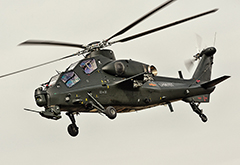The CAIC Z-10 (WZ-10) is a Chinese medium attack helicopter developed for the People's Liberation Army Ground Force. It is designed primarily for anti-tank warfare missions but has secondary air-to-air combat capability as well. Initiated by chief designer Wu Ximing, the project had early Russian involvement with Kamov Design Bureau of Russia under a contract with the Chinese government, but the collaboration was abruptly stopped due to fundamental design philosophy disagreements. The Chinese designers and their customer, the PLA General Armaments Department, preferred an lighter-weight, more agile airframe with less emphasis on armor. The helicopter was further developed by Changhe Aircraft Industries Corporation (CAIC) and locally manufactured.
Nicknames of characters in the Chinese classic novel Water Margin have been used to name Z-10 and its light-weight counterpart Harbin Z-19: Z-10 is called Fierce Thunderbolt (Pi Li Huo, 霹雳火), the nickname of Qin Ming, while Z-19 is called Black Whirlwind (Hei Xuan Feng, 黑旋风), the nickname of Li Kui.
Nicknames of characters in the Chinese classic novel Water Margin have been used to name Z-10 and its light-weight counterpart Harbin Z-19: Z-10 is called Fierce Thunderbolt (Pi Li Huo, 霹雳火), the nickname of Qin Ming, while Z-19 is called Black Whirlwind (Hei Xuan Feng, 黑旋风), the nickname of Li Kui.
In September 2016, the PLA announced that all of its army aviation units had been equipped with the WZ-10.
The Kamov design bureau was contracted to perform the development work under a secret contract. Kamov worked with the Chinese to establish base specifications, such as weight, speed and payload capacity after which they had full freedom to design the helicopter. Kamov designed, tested and verified the helicopter design, after which it was provided to the Chinese team. Although designed in Russia, the prototype construction, flight testing and further development was performed by the Chinese.
Wu Ximing (吴希明) of the 602nd Research Institute, one of the Chinese top scientists involved in the 863 Program was publicly credited with being the chief designer of the Z-10, in an attempt to preserve the secrecy of the Kamov contract. Wu had earlier participated in the designs of the armed version of transport helicopters Z-8A and WZ-9. In order to complete the necessary development, the 602nd Research Institute and CAIC had jointly built a new engineering design center, industrial simulator, aircraft engine ground test center, fatigue laboratory, and rotary test platform (nicknamed as Iron Bird Platform, 铁鸟台). In the end of 2001, the final test was completed on the full-scale rotary test platform, paving the way for test flights.
Composite material is widely used in the Z-10 but China faced difficulties in this field, particularly in the area of survivability during crashes. Huge efforts were spent to domestically develop composite materials able to provide comparable levels of survivability to Western counterparts. This achievement earned a second place in the Commission for Science, Technology and Industry for National Defense (COSTIND) progress reward. More details
